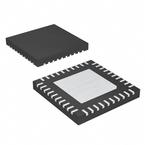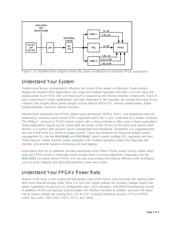herunterladen

Maxim > Design Support > Technical Documents > Application Notes > Power-Supply Circuits > APP 5447
Keywords: FPGA, field-programmable gate array, power supply, complex programmable logic device,
CPLD, programmable logic device, PLD, point-of-load, POL, POL regulator
APPLICATION NOTE 5447
Choose the Right Power Supply for Your FPGA
By: Viral Vaidya, Business Manager
Oct 10, 2012
Abstract: There are many things to consider when designing a power supply for a field-programmable
gate array (FPGA). These include (but are not limited to) the high number of voltage rails, and the
differing requirements for both sequencing/tracking and the voltage ripple limits. This application note
explains these and other power-supply considerations that an engineer must think through when
designing a power supply for an FPGA.
A similar version of this article appeared in the August 1, 2012 issue of Electronic Specifier magazine.
Introduction
Field-programmable gate arrays (FPGAs) and complex programmable logic devices (CPLDs) require 3 to
15, or even more, voltage rails. The logic fabric is usually at the latest process technology node that
determines the core supply voltage. Configuration, housekeeping circuitry, various I/Os,
serializer/deserializer (SerDes) transceivers, clock managers, and other functions all have differing
requirements for voltage rails, sequencing/tracking, and voltage ripple limits. An engineer must consider
all of these issues when designing a power supply for an FPGA.
Power Requirements Start with the Voltage Rails
As programmable logic devices (PLDs) and FPGAs assume the role of a system on a chip (SoC) on
your board, powering these devices is comparable to powering an entire system. High-end FPGAs such
as the Xilinx® Virtex® M series and the Altera® Stratix® series easily have 10 to15 unique rails. Lower-
density FPGAs such as the Xilinx Kintex® and Spartan® series or the Altera Arria® and Cyclone® series
can have 2 to10 rails, depending on the application.
With FPGAs varying so greatly, it is critical that you choose the right power supply for each application.
You must define the set of power regulators for the overall power level of each rail, the rails' sequencing
requirements, and system power-management needs. Moreover, as process technology nodes become
smaller in FPGAs, tighter tolerances are needed on the voltage-supply rails. This is why regulators with
1% regulation accuracy across line/load and process-voltage-temperature (PVT) variations are so critical
(Figure 1).
Page 1 of 4






